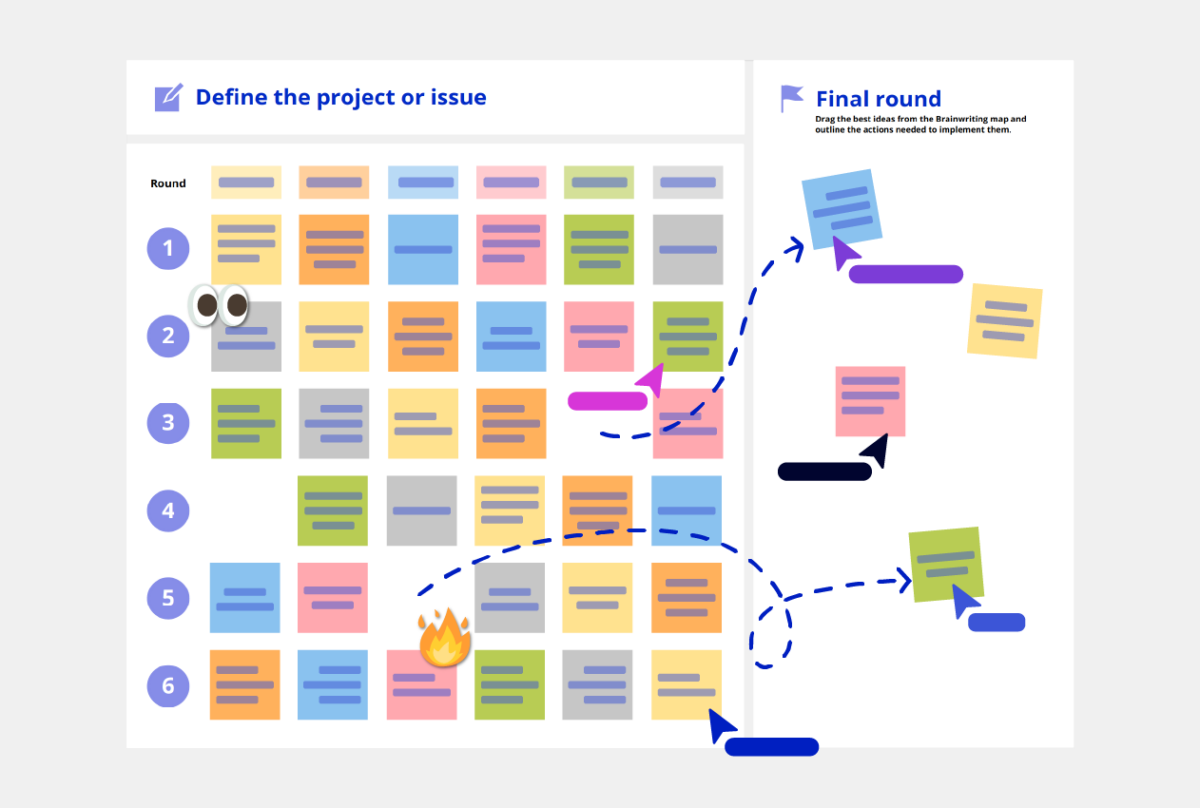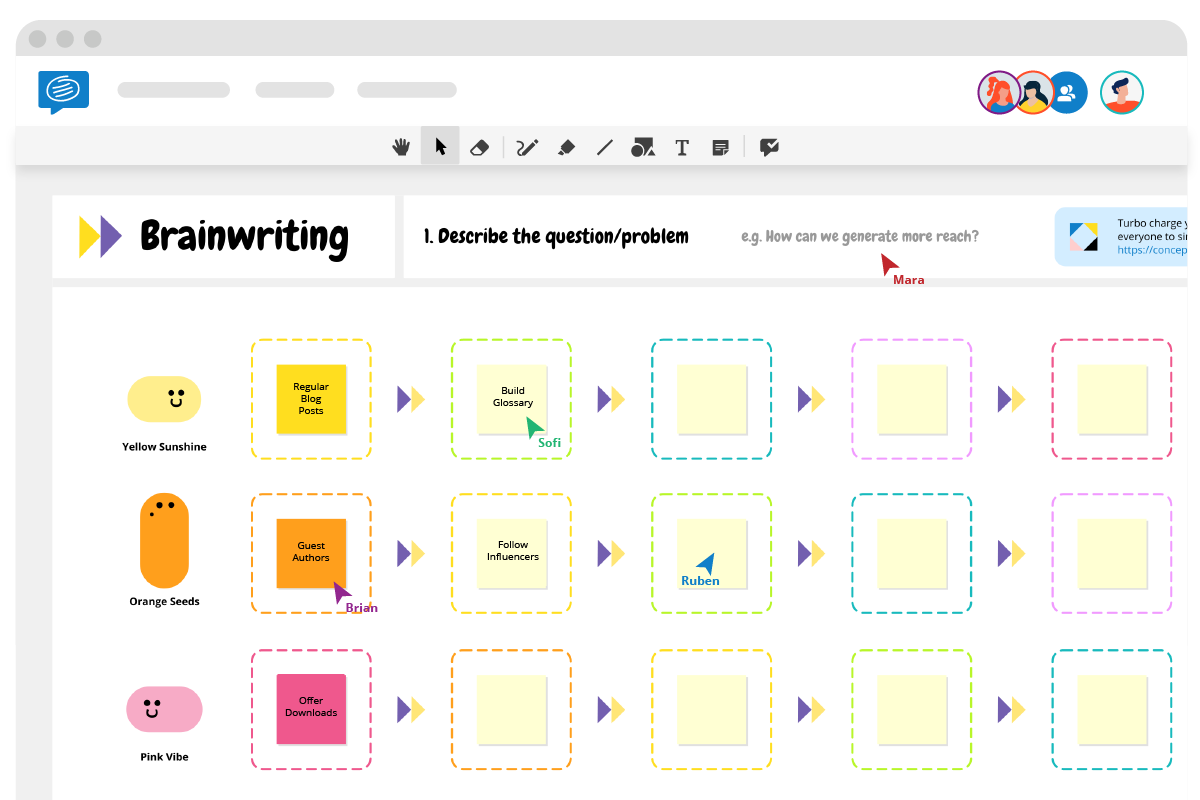Use the brainwriting technique to boost idea generation
Brainwriting is designed to counteract this. It’s a new way of brainstorming that’s designed to help you get more ideas from everyone in the group.

Brainstorming is a great way to explore new ideas or solutions to a problem. But it can also be flawed as those with louder voices, stronger personalities or higher positions often dominate the session, leaving those shyer, more introverted team members feeling left out. Their ideas may never be heard, or if they are, they’ll likely be pushed to the side.
Brainwriting is designed to counteract this. It’s a new way of brainstorming that’s designed to help you get more ideas from everyone in the group.
Our collaborative brainwriting template is designed to turbocharge your ideation sessions. Jump into the template below, or read on to understand how to easily include this brainwriting into your idea generation methodologies.
What is brainwriting?
Put simply, brainwriting is the introvert’s version of brainstorming. Each person is given a blank page to write down three ideas, then after five minutes, all pages are collected and passed onto someone else, who can continue to explore those existing ideas, or add their own. If you’d like to explore alternative brainstorming techniques, we’ve rounded up a list of 15 brainstorming techniques and templates you can use collaboratively with your team.
Brainwriting is designed to reduce the unnecessary chit-chat and allow everyone to simultaneously add ideas, thus speeding up the process, and reduce social anxiety and ridicule. Perhaps best of all, brainwriting is effective at eliminating blocking: the problem where people forget or dismiss their own ideas due to one person dominating the discussion with their ideas.

Brainwriting techniques
The 6-3-5 brainwriting method (Method 365) is one of the most common ways of brainwriting.
6 people – 3 ideas – 5 minutes.
It involves gathering six team members, each person adds three ideas, during five minute brainstorming rounds. Across a total of six rounds, you should be able to generate 108 ideas in 30 minutes.
The key here is that after each round, team members pass their paper or board on to the next person. This cyclical nature of brainstorming produces more varied and progressive results as each person gains inspiration from the other ideas.
Brainwriting in Design Thinking
Brainwriting is an effective ideation method in the ideation stage of the Design Thinking process. Participants analyze the problem statement individually, ideate, and write down their ideas on cards. These cards are then passed on to other participants, who are then expected to build on the previous person’s ideas. At the end of the process, the cards are collected and posted for instant discussions.
How do I conduct a remote brainwriting session?
Regardless of whether your team is fully remote, co-located or currently working from home, with Conceptboard’s online digital collaboration space, everyone can participate in a brainwriting workshop.
We’ve designed a simple, ready-to-use brainwriting template to save you time. So let’s get started.

- The moderator should set up a meeting and invite six team members to join a brainwriting session by sending them a link to the blank template. (Normally you would invite everyone to join one board, but in this case, everyone needs to work on their own individual board)
- At the beginning of the workshop, ask everyone to write the problem statement you are trying to solve at the top of their page.
- Begin the first round by giving everyone five minutes to jot down three possible solutions in the first column. These can be written on sticky notes, creatively illustrated or visually shown using pictures.
- After the first round, ask everyone to send the link to their board to the moderator (ensuring access role is set to editor), then the moderator should send everyone a link to a new board. This way, all ideas remain anonymous and people will feel more comfortable sharing their wackiest ideas without judgement.
- Give everyone another five minutes to add three more new ideas to the second column, either taking the original ideas further or generating entirely new ones.
- Continue this process of idea generation and redistribution of boards until you’ve completed all four rounds.
- In the final round, ask everyone to select the three best ideas on the board they have, and add them in the final column.
- Now it’s time to share the three best ideas on their board with the wider group in a video or phone call. You can collect them on a new blank page to easily collect and save those winning ideas.
Tip: If you don’t have a moderator but want to keep anonymity, list the links to all the boards in a numbered list in an email, then allocate every team member a number. Ask everyone to begin with the board matching their number, and then open subsequent numbered boards each round.
Hopefully, the use of the brainwriting template has generated a great selection of unique and well-thought-out ideas that you can then explore further. The idea prioritization template can help you in the next stage of deciding which ideas to pursue. You might also be interested in learning about how Design Thinking can help with creative problem-solving.
So next time you are considering a brainstorming session, why not give brainwriting a go and see just how creative your team can be.
If you would like to explore more free templates and resources, check out our popular blog.

